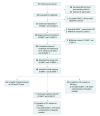Ambroxol for the Treatment of Patients With Parkinson Disease With and Without Glucocerebrosidase Gene Mutations: A Nonrandomized, Noncontrolled Trial
- PMID: 31930374
- PMCID: PMC6990847
- DOI: 10.1001/jamaneurol.2019.4611
Ambroxol for the Treatment of Patients With Parkinson Disease With and Without Glucocerebrosidase Gene Mutations: A Nonrandomized, Noncontrolled Trial
Abstract
Importance: Mutations of the glucocerebrosidase gene, GBA1 (OMIM 606463), are the most important risk factor for Parkinson disease (PD). In vitro and in vivo studies have reported that ambroxol increases β-glucocerebrosidase (GCase) enzyme activity and reduces α-synuclein levels. These observations support a potential role for ambroxol therapy in modifying a relevant pathogenetic pathway in PD.
Objective: To assess safety, tolerability, cerebrospinal fluid (CSF) penetration, and target engagement of ambroxol therapy with GCase in patients with PD with and without GBA1 mutations.
Interventions: An escalating dose of oral ambroxol to 1.26 g per day.
Design, setting, and participants: This single-center open-label noncontrolled clinical trial was conducted between January 11, 2017, and April 25, 2018, at the Leonard Wolfson Experimental Neuroscience Centre, a dedicated clinical research facility and part of the University College London Queen Square Institute of Neurology in London, United Kingdom. Participants were recruited from established databases at the Royal Free London Hospital and National Hospital for Neurology and Neurosurgery in London. Twenty-four patients with moderate PD were evaluated for eligibility, and 23 entered the study. Of those, 18 patients completed the study; 1 patient was excluded (failed lumbar puncture), and 4 patients withdrew (predominantly lumbar puncture-related complications). All data analyses were performed from November 1 to December 14, 2018.
Main outcomes and measures: Primary outcomes at 186 days were the detection of ambroxol in the CSF and a change in CSF GCase activity.
Results: Of the 18 participants (15 men [83.3%]; mean [SD] age, 60.2 [9.7] years) who completed the study, 17 (8 with GBA1 mutations and 9 without GBA1 mutations) were included in the primary analysis. Between days 0 and 186, a 156-ng/mL increase in the level of ambroxol in CSF (lower 95% confidence limit, 129 ng/mL; P < .001) was observed. The CSF GCase activity decreased by 19% (0.059 nmol/mL per hour; 95% CI, -0.115 to -0.002; P = .04). The ambroxol therapy was well tolerated, with no serious adverse events. An increase of 50 pg/mL (13%) in the CSF α-synuclein concentration (95% CI, 14-87; P = .01) and an increase of 88 ng/mol (35%) in the CSF GCase protein levels (95% CI, 40-137; P = .002) were observed. Mean (SD) scores on part 3 of the Movement Disorders Society Unified Parkinson Disease Rating Scale decreased (ie, improved) by 6.8 (7.1) points (95% CI, -10.4 to -3.1; P = .001). These changes were observed in patients with and without GBA1 mutations.
Conclusions and relevance: The study results suggest that ambroxol therapy was safe and well tolerated; CSF penetration and target engagement of ambroxol were achieved, and CSF α-synuclein levels were increased. Placebo-controlled clinical trials are needed to examine whether ambroxol therapy is associated with changes in the natural progression of PD.
Trial registration: ClinicalTrials.gov identifier: NCT02941822; EudraCT identifier: 2015-002571-24.
Conflict of interest statement
Figures


Comment in
-
Precision Medicine for Parkinson's Disease: Ambroxol for Glucocerebrosidase-Associated Parkinson's Disease, First Trial Completed.Mov Disord. 2020 Jul;35(7):1134-1135. doi: 10.1002/mds.28072. Epub 2020 May 7. Mov Disord. 2020. PMID: 32379375 No abstract available.
References
-
- Grabowski GA, Zimran A, Ida H. Gaucher disease types 1 and 3. Am J Hematol. 2015;90(suppl 1):S12-S18. - PubMed
-
- Anheim M, Elbaz A, Lesage S, et al. ; French Parkinson Disease Genetic Group . Penetrance of Parkinson disease in glucocerebrosidase gene mutation carriers. Neurology. 2012;78(6):417-420. - PubMed
Publication types
MeSH terms
Substances
Associated data
Grants and funding
LinkOut - more resources
Full Text Sources
Other Literature Sources
Medical
Miscellaneous

